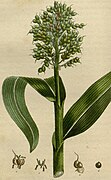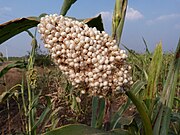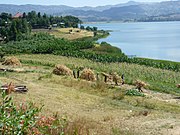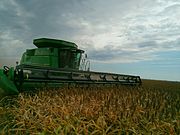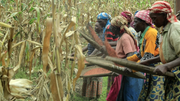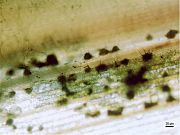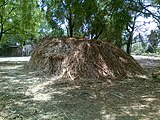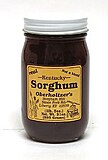Sorghum
| Sorghum | |
|---|---|
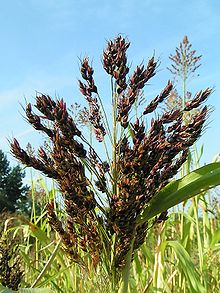
| |
| Scientific classification | |
| Kingdom: | Plantae |
| Clade: | Tracheophytes |
| Clade: | Angiosperms |
| Clade: | Monocots |
| Clade: | Commelinids |
| Order: | Poales |
| Family: | Poaceae |
| Subfamily: | Panicoideae |
| Genus: | Sorghum |
| Species: | S. bicolor
|
| Binomial name | |
| Sorghum bicolor | |
| Synonyms[1] | |
|
List
| |
Sorghum bicolor, commonly called sorghum[2] (/ˈsɔːrɡəm/) and also known as great millet,[3] broomcorn,[4] guinea corn,[5] durra,[6] imphee,[7] jowar,[8] or milo,[9] is a species in the grass genus Sorghum cultivated for its grain. The grain is used for food for humans; the plant is used for animal feed and ethanol production. Sorghum originated in Africa, and is now cultivated widely in tropical and subtropical regions.
Sorghum is the world's fifth-most important cereal crop after rice, wheat, maize, and barley. Sorghum is typically an annual, but some cultivars are perennial. It grows in clumps that may reach over 4 metres (13 ft) high. The grain is small, 2 to 4 millimetres (0.079 to 0.157 in) in diameter. Sweet sorghums are cultivars primarily grown for forage, syrup production, and ethanol; they are taller than those grown for grain.
Description[edit]
Sorghum is a large stout grass that grows up to 2.4 metres (7.9 ft) tall. It has large bushy flowerheads or panicles that provide an edible starchy grain with up to 3,000 seeds in each flowerhead. It grows in warm climates worldwide for food and forage.[10][11][12] Sorghum is native to Africa with many cultivated forms.[13][14] Most production uses annual cultivars, but some wild species of Sorghum are perennial; the Land Institute is developing a perennial cultivar that would enable farmers to "produce repeated, sufficient grain harvests without resowing."[15]
-
Botanical illustration of Sorghum bicolor or great millet, one of some 25 species in the Sorghum genus
-
S. bicolor with maturing panicles of grain, Germany
-
Ripe panicle of S. bicolor, India
-
Branch of panicle with spikelets
Evolution[edit]
Phylogeny[edit]
Sorghum is closely related to maize within the PACMAD clade of grasses, and more distantly to the cereals of the BOP clade such as wheat and barley.[16]
| (Part of Poaceae) |
| ||||||||||||
History[edit]
Domestication[edit]

S. bicolor was domesticated from its wild ancestor more than 5,000 years ago in Eastern Sudan in the area of the Rivers Atbara and Gash.[18][19] It has been found at an archaeological site near Kassala in eastern Sudan, dating from 3500 to 3000 BC, and is associated with the neolithic Butana Group culture.[20] Sorghum bread from graves in Predynastic Egypt, some 5,100 years ago, is displayed in the Egyptian Museum, Turin, Italy.[17]
The first race to be domesticated was bicolor; it had tight husks that had to be removed forcibly. Around 4,000 years ago, this spread to the Indian subcontinent; around 3,000 years ago it reached West Africa.[18] Four other races evolved through cultivation to have larger grains and to become free-threshing, making harvests easier and more productive. These were caudatum in the Sahel; durra, most likely in India; guinea in West Africa (later reaching India), and from that race mageritiferum that gave rise to the varieties of Southern Africa.[18]

Spread[edit]

In the Middle Ages, the Arab Agricultural Revolution spread sorghum and other crops from Africa and Asia across the Arab world as far as Al-Andalus in Spain.[21] Sorghum remained the staple food of the medieval kingdom of Alodia and most Sub-Saharan cultures prior to European colonialism.[22]
Tall varieties of sorghum with a high sugar content are called sweet sorghum; they are useful for producing a sugar-rich syrup and as forage.[23][24] Sweet sorghum was important to the sugar trade in the 19th century.[25] The price of sugar was rising because of decreased production in the British West Indies and more demand for confectionery and fruit preserves, and the United States was actively searching for a sugar plant that could be produced in northern states. The "Chinese sugar-cane", sweet sorghum, was viewed as a plant that would be productive in the West Indies.[26]
The name sorghum derives from Italian sorgo, which in turn most likely comes from 12th century Medieval Latin surgum or suricum. This in turn may be from Latin syricum, meaning "[grass] of Syria".[27]
Cultivation[edit]
Agronomy[edit]
Most varieties of sorghum are drought- and heat-tolerant, nitrogen-efficient,[28] and are grown particularly in arid and semi-arid regions where the grain is one of the staples for poor and rural people. These varieties provide forage in many tropical regions. S. bicolor is a food crop in Africa, Central America, and South Asia, and is the fifth most common cereal crop grown in the world.[29][30] It is most often grown without application of fertilizers or other inputs by small-holder farmers in developing countries.[31] They benefit from sorghum's ability to compete effectively with weeds, especially when it is planted in narrow rows. Sorghum actively suppresses weeds by producing sorgoleone, an alkylresorcinol.[32]
Sorghum grows in a wide range of temperatures. It can tolerate high altitude and toxic soils, and can recover growth after some drought.[23] Optimum growth temperature range is 12–34 °C (54–93 °F), and the growing season lasts for ~ 115-140 days. [33] It can grow on a wide range of soils, such as heavy clay to sandy soils with the pH tolerance ranging from 5.0 to 8.5.[34] It requires an arable field that has been left fallow for at least two years or where crop rotation with legumes has taken place in the previous year.[35] Diversified 2- or 4-year crop rotation can improve sorghum yield, additionally making it more resilient to inconsistent growth conditions.[36] In terms of nutrient requirements, sorghum is comparable to other cereal grain crops with nitrogen, phosphorus, and potassium required for growth.[37]
An international effort is under way to improve sorghum farming. The International Crops Research Institute for the Semi-Arid Tropics has improved sorghum using traditional genetic improvement and integrated genetic and natural resources management practices. New varieties of sorghum from the institute has now resulted in India producing 7 metric tons per hectare (2.8 long ton/acre; 3.1 short ton/acre).[38] Some 194 improved cultivars are now planted worldwide. In India, increases in sorghum productivity resulting from improved cultivars have freed up 7 million hectares (17 million acres) of land, enabling farmers to diversify into high-income cash crops and boost their livelihoods.[39] Sorghum is used primarily as poultry feed, and secondarily as cattle feed and in brewing applications.[40]
-
Sorghum harvest at the shore of Lake Hayq, Ethiopia, 2012
-
Harvesting sorghum in Oklahoma, USA, with a combine harvester
-
Drying sorghum in the open air, Uganda, 2020
-
Women drying sorghum seeds by tossing them in trays, 2022
Pests and diseases[edit]
Insect damage is a major threat to sorghum plants. Over 150 species damage crop plants at different stages of development, resulting in significant biomass loss.[41] Stored sorghum grain is attacked by other insect pests such as the lesser grain borer beetle.[42] Sorghum is a host of the parasitic plant Striga hermonthica, purple witchweed; it can seriously reduce production.[43] Sorghum is subject to a variety of plant pathogens. The fungus Colletotrichum sublineolum causes anthracnose.[44] The toxic ergot fungus parasitises the grain, risking harm to humans and livestock.[45] Sorghum produces chitinases as defensive compounds against fungal diseases. Transgenesis of additional chitinases increases the crop's disease resistance.[46]
-
The lesser grain borer is a serious pest of sorghum.
-
Acervuli of Colletotrichum sublineolum, the cause of anthracnose, on sweet sorghum
-
Sorghum leaves showing anthracnose damage
Genetics and genomics[edit]
The genome of S. bicolor was sequenced between 2005 and 2007.[47][48] It is generally considered diploid and contains 20 chromosomes,[49] however, there is evidence to suggest a tetraploid origin for S. bicolor.[50] The genome size is approximately 800 Mbp.[51]
Paterson et al., 2009 provides a genome assembly of 739 megabase. The most commonly used genome database is SorGSD maintained by Luo et al., 2016. A gene expression atlas is available from Shakoor et al., 2014 with 27,577 genes. For molecular breeding (or other purposes) an SNP array has been created by Bekele et al., 2013, a 3K SNP Infinium from Illumina, Inc.[52]
Agrobacterium transformation can be used on sorghum, as shown in a 2018 report of such a transformation system.[53] A 2013 study developed and validated an SNP array for molecular breeding.[52][54]
Production[edit]
| Sorghum production – 2021 | |
|---|---|
| Country | (Millions of tonnes) |
| 11.4 | |
| 4.8 | |
| 4.4 | |
| 4.4 | |
| 3.3 | |
| 3.0 | |
| World | 61.4 |
| Source: FAOSTAT of the United Nations[55] | |
In 2021, world production of sorghum was 61 million tonnes, led by the United States with 19% of the total (table). India, Ethiopia, and Mexico were the largest secondary producers.[55]
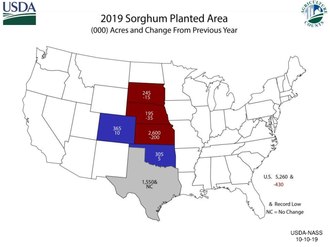
International trade[edit]
In 2013, China began purchasing American sorghum as a complementary livestock feed to its domestically grown maize. It imported around $1 billion worth per year until April 2018, when it imposed retaliatory tariffs as part of a trade war.[56] By 2020, the tariffs have been waived, and trade volumes increased again[57] before declining again as China began buying sorghum from other countries.[58] As of 2020, China is the world's largest sorghum importer, importing more than all other countries combined.[57]
Nutrition[edit]
| Nutritional value per 100 g (3.5 oz) | |
|---|---|
| Energy | 329 kJ (79 kcal) |
72.1 g | |
| Sugars | 2.53 g |
| Dietary fiber | 6.7 g |
3.46 g | |
| Saturated | 0.61 g |
| Monounsaturated | 1.13 g |
| Polyunsaturated | 1.56 g |
10.6 g | |
| Vitamins | Quantity %DV† |
| Vitamin A equiv. | 0% 0 μg |
| Thiamine (B1) | 28% 0.332 mg |
| Riboflavin (B2) | 7% 0.096 mg |
| Niacin (B3) | 23% 3.69 mg |
| Pantothenic acid (B5) | 7% 0.367 mg |
| Vitamin B6 | 26% 0.443 mg |
| Folate (B9) | 5% 20 μg |
| Vitamin C | 0% 0 mg |
| Vitamin E | 3% 0.5 mg |
| Minerals | Quantity %DV† |
| Calcium | 1% 13 mg |
| Copper | 32% 0.284 mg |
| Iron | 19% 3.36 mg |
| Magnesium | 39% 165 mg |
| Manganese | 70% 1.6 mg |
| Phosphorus | 23% 289 mg |
| Potassium | 12% 363 mg |
| Selenium | 22% 12.2 μg |
| Sodium | 0% 2 mg |
| Zinc | 15% 1.67 mg |
| Other constituents | Quantity |
| Water | 12.4 g |
| †Percentages estimated using US recommendations for adults,[59] except for potassium, which is estimated based on expert recommendation from the National Academies.[60] | |
The grain is edible and nutritious. It can be eaten raw when young and milky, but has to be boiled or ground into flour when mature.[61]
Sorghum grain is 72% carbohydrates including 7% dietary fiber, 11% protein, 3% fat, and 12% water (table). In a reference amount of 100 grams (3.5 oz), sorghum grain supplies 79 calories and rich contents (20% or more of the Daily Value, DV) of several B vitamins and dietary minerals (table).
In the early stages of plant growth, some sorghum species may contain levels of hydrogen cyanide, hordenine, and nitrates lethal to grazing animals.[62] Plants stressed by drought or heat can also contain toxic levels of cyanide and nitrates at later stages in growth.[63]
Use[edit]
Sorghum is widely used for food and animal fodder. It is also used to make alcoholic beverages, and biofuels such as ethanol.[11] It can be made into couscous, porridge, or flatbreads such as Indian Jōḷada roṭṭi or tortillas; and it can be burst in hot oil to make a popcorn, smaller than that of maize. Since it does not contain gluten, it can be used in gluten-free diets.[64]
In Nigeria, the pulverized red leaf-sheaths of sorghum have been used to dye leather, while in Algeria, sorghum has been used to dye wool.[65]
In South Africa, characteristically sour Kaffir beer is made from sorghum or millet. The process involves souring the mashed grain with lactic acid bacteria, followed by fermenting by the wild yeasts that were on the grain.[66]
In India, the panicle stalks are used as bristles for brooms.[67]
In countries including the US, the stalks of sweet sorghum varieties are crushed in a cane juicer to extract the sweet molasses-like juice. The juice is sold as syrup,[68][69][70] and used as a feedstock to make biofuel.[71]
-
Sorghum dough in a gourd bowl of the Didinga people of South Sudan
-
Jōḷada roṭṭi flatbread, Karnataka, India
-
Maize popcorn and popped sorghum
-
Sorghum forage, Maharashtra, India
-
Sorghum beer, Omalovu giilya, fermenting in gourds, Namibia
-
Brooms made of panicle stalks
-
A horse-driven sorghum cane juicer being used to extract the sweet juice in North Carolina
-
A jar of sweet sorghum syrup
In human culture[edit]
In Australia, sorghum is personified as a spirit among the Dagoman people of Northern Territory, as well as being used for food; the local species are S. intrans and S. plumosum.[72]
In Korea, the origin tale "Brother and sister who became the Sun and Moon" is also called "The reason sorghum is red".[73] In the tale, a tiger who is chasing a brother and sister follows them up a rotten rope as they climb into the sky, and become the sun and moon. The rope breaks, and the tiger falls to its death, impaling itself on a sorghum stalk, which becomes red with its blood.[74]
In Northeastern Italy in the early modern period, sticks of sorghum were used by Benandanti visionaries of the Friuli district to fight off witches who were thought to threaten crops and people.[75]
See also[edit]
References[edit]
- ^ "Sorghum bicolor (L.) Moench — The Plant List". www.theplantlist.org.
- ^ USDA, NRCS (n.d.). "Sorghum bicolor". The PLANTS Database (plants.usda.gov). Greensboro, North Carolina: National Plant Data Team. Retrieved 2 February 2016.
- ^ BSBI List 2007 (xls). Botanical Society of Britain and Ireland. Archived from the original (xls) on 2015-06-26. Retrieved 2014-10-17.
- ^ "Definition of BROOMCORN". www.merriam-webster.com. Retrieved 2021-12-14.
- ^ "Definition of GUINEA CORN". www.merriam-webster.com. Retrieved 2021-12-14.
- ^ "Definition of DURRA". www.merriam-webster.com. Retrieved 2021-12-14.
- ^ "Definition of IMPHEE". www.merriam-webster.com. Retrieved 2021-12-14.
- ^ "jowar". The Free Dictionary. Retrieved 2021-12-14.
- ^ "Definition of MILO". www.merriam-webster.com. Retrieved 2021-12-14.
- ^ "Sorghum". County-level distribution maps from the North American Plant Atlas (NAPA). Biota of North America Program (BONAP). 2014. Retrieved 4 September 2016.
- ^ a b "sorghum: grain". Britannica. Retrieved 6 May 2024.
- ^ Mutegi, Evans; Sagnard, Fabrice; Muraya, Moses; et al. (2010-02-01). "Ecogeographical distribution of wild, weedy and cultivated Sorghum bicolor (L.) Moench in Kenya: implications for conservation and crop-to-wild gene flow" (PDF). Genetic Resources and Crop Evolution. 57 (2): 243–253. doi:10.1007/s10722-009-9466-7. S2CID 28318220.
- ^ Hauser, Stefan; Wairegi, Lydia; Asadu, Charles L.A.; Asawalam, Damian O.; Jokthan, Grace; Ugbe, Utiang (2015). "Sorghum- and millet-legume cropping systems" (PDF). Centre for Agriculture and Bioscience International and Africa Soil Health Consortium. Retrieved 7 October 2018.
- ^ Dillon, Sally L.; Shapter, Frances M.; Henry, Robert J.; et al. (1 September 2007). "Domestication to Crop Improvement: Genetic Resources for Sorghum and Saccharum (Andropogoneae)". Annals of Botany. 100 (5): 975–989. doi:10.1093/aob/mcm192. PMC 2759214. PMID 17766842.
- ^ "Perennial Sorghum". The Land Institute. Retrieved 7 May 2024.
- ^ a b "Pane di sorgo contenuto nel cesto S. 283; fa parte del corredo funerario infantile della mummia S. 278". Egyptian Museum, Turin. Retrieved 6 May 2024.
S. 285, la 15 Vetrina 02
- ^ a b c d Fuller, Dorian Q.; Stevens, Chris J. (2018). "Sorghum Domestication and Diversification: A Current Archaeobotanical Perspective". Plants and People in the African Past. Springer International Publishing. pp. 427–452. doi:10.1007/978-3-319-89839-1_19. ISBN 978-3-319-89838-4.
- ^ Carney, Judith (2009). In the Shadow of Slavery. University of California Press. p. 16. ISBN 978-0-5202-6996-5.
- ^ Winchell, Frank; Stevens, Chris J.; Murphy, Charlene; Champion, Louis; Fuller, Dorian Q. (2017). "Evidence for sorghum domestication in fourth millennium BC eastern Sudan: Spikelet morphology from ceramic impressions of the Butana Group" (PDF). Current Anthropology. 58 (5): 673–683.
- ^ Watson, Andrew M. (1974). "The Arab Agricultural Revolution and Its Diffusion, 700–1100". The Journal of Economic History. 34 (1): 8–35. doi:10.1017/S0022050700079602. JSTOR 2116954. S2CID 154359726.
- ^ Welsby, Derek (2002). "The Economy", in The Medieval Kingdoms of Nubia. Pagans, Christians and Muslims Along the Middle Nile. British Museum. ISBN 978-0-7141-1947-2.
- ^ a b "Grassland Index: Sorghum bicolor (L.) Moench". Archived from the original on 2017-11-19. Retrieved 2006-08-24.
- ^ "Sweet Sorghum". Sweet Sorghum Ethanol Producer s. Retrieved 13 November 2012.
- ^ Hyde, James F.C. (1857). The Chinese Sugar-Cane: Its History, Mode of Culture, Manufacture of the Sugar, Etc. with Reports of Its Success in Different Portions of the United States, and Letters from Distinguished Men. Boston: J. P. Jewett.
- ^ Hyde, James F.C. (1857). The Chinese Sugar-Cane: Its History, Mode of Culture, Manufacture of the Sugar, Etc. with Reports of Its Success in Different Portions of the United States, and Letters from Distinguished Men. Boston: J. P. Jewett. p. 11.
- ^ "sorghum (n.)". Online Etymology Dictionary. Retrieved 7 May 2024.
- ^ Mulhollem, Jeff (10 August 2020). "Flavonoids' presence in sorghum roots may lead to frost-resistant crop". Pennsylvania State University.
sorghum is a crop that can respond to climate change because of its high water- and nitrogen-use efficiency
- ^ Danovich, Tove (15 December 2015). "Move over, quinoa: sorghum is the new 'wonder grain'". The Guardian. Retrieved 31 July 2018.
- ^ Willy H. Verheye, ed. (2010). "Growth and Production of Sorghum and Millets". Soils, Plant Growth and Crop Production. Vol. II. EOLSS Publishers. ISBN 978-1-84826-368-0.
- ^ "Sorghum and millet in human nutrition". Food and Agriculture Organization of the United Nations. 1995.
- ^ USDA ARS. "Tapping into Sorghum's Weed Fighting Capabilities to Give Growers More Options". USDA ARS. Retrieved 2021-07-27.
- ^ "Sorghum - Section 4: Plant Growth and Physiology" (PDF). Grain Research & Development Corporation. Archived from the original (PDF) on 11 November 2022. Retrieved 4 December 2022.
- ^ Smith, C. Wayne; Frederiksen, Richard A. (2000). Sorghum: Origin, History, Technology, and Production. John Wiley & Sons. ISBN 978-0-4712-4237-6.
- ^ Ajeigbe, Hakeem A. (2020). Handbook on improved agronomic practices of sorghum production in north east Nigeria. Patancheru: ICRISAT.
- ^ Sindelar, Aaron J.; Schmer, Marty R.; Jin, Virginia L.; Wienhold, Brian J.; Varvel, Gary E. (2016). "Crop Rotation Affects Corn, Grain Sorghum, and Soybean Yields and Nitrogen Recovery". Agronomy Journal. 108 (4): 1592–1602. doi:10.2134/agronj2016.01.0005.
- ^ Rooney, W.L. (2016). "Sorghum". Reference Module in Food Science. doi:10.1016/B978-0-08-100596-5.02986-3. ISBN 9780081005965.
- ^ Rajulapudi, Srinivas (16 March 2014). "India beats China in sorghum production". The Hindu. Retrieved 17 March 2014.
- ^ "Archived copy" (PDF). Archived from the original (PDF) on 2016-01-20. Retrieved 2014-03-16.
{{cite web}}: CS1 maint: archived copy as title (link) Sorghum, a crop of substance. Downloaded 16 March 2014. - ^ "General Sorghum". Agricultural Resource Marketing Center - partially funded by U.S. Department of Agriculture Rural Development Program. 2011. Archived from the original on 2012-07-25. Retrieved 2012-06-26.
- ^ Guo, Chunshan; Cui, Wei; Feng, Xue; Zhao, Jianzhou; Lu, Guihua (2011). "Sorghum insect problems and management". Journal of Integrative Plant Biology. 53 (3): 178–192. doi:10.1111/J.1744-7909.2010.01019.X. PMID 21205185.
- ^ Edde, Peter A. (2012). "A review of the biology and control of Rhyzopertha dominica (F.) the lesser grain borer". Journal of Stored Products Research. 48 (1). Elsevier: 1–18. doi:10.1016/j.jspr.2011.08.007. ISSN 0022-474X. S2CID 84377289.
- ^ Yoshida, Satoko; Maruyama, Shinichiro; Nozaki, Hisayoshi; Shirasu, Ken (28 May 2010). "Horizontal Gene Transfer by the Parasitic Plant Stiga hermanthica". Science. 328 (5982): 1128. Bibcode:2010Sci...328.1128Y. doi:10.1126/science.1187145. PMID 20508124. S2CID 39376164.
- ^ Ero, T.; Hirpa, D.; Seid, A. (2018). Anthracnose of sorghum-Ethiopia: Colletotrichum sublineolum (C. graminicola); yemashila michi (Report). Pest Management Decision Guides. Plantwiseplus Knowledge Bank. doi:10.1079/pwkb.20157800477. S2CID 253929998.
- ^ Bandyopadhyay, Ranajit; Frederickson, Debra E.; McLaren, Neal W.; Odvody, Gary N.; Ryley, Malcolm J. (April 1998). "Ergot: A New Disease Threat to Sorghum in the Americas and Australia". Plant Disease. 82 (4): 356–367. doi:10.1094/PDIS.1998.82.4.356. PMID 30856881.
- ^ Paterson, Andrew H.; John E. Bowers; Remy Bruggmann; Inna Dubchak; Jane Grimwood; Heidrun Gundlach; et al. (2009-01-29). "The Sorghum bicolor genome and the diversification of grasses". Nature. 457 (7229): 551–556. Bibcode:2009Natur.457..551P. doi:10.1038/nature07723. ISSN 0028-0836. PMID 19189423.
- ^ "Phytozome". US DOE JGI Phytozome.
- ^ Price, H. J.; Dillon, S. L.; Hodnett, G.; Rooney, W. L.; Ross, L.; Johnston, J. S. (2005). "Genome evolution in the genus Sorghum (Poaceae)". Annals of Botany. 95 (1): 219–227. doi:10.1093/aob/mci015. PMC 4246720. PMID 15596469.
- ^ Gomez, M. I.; Islam-Faridi, M. N.; Zwick, M. S.; Czeschin Jr, D. G.; Hart, G. E.; Wing, R. A.; Stelly, D. M.; Price, H. J. (1998). "Brief communication. Tetraploid nature of Sorghum bicolor (L.) Moench". Journal of Heredity. 89 (2): 188–190. doi:10.1093/jhered/89.2.188.
- ^ McCormick, Ryan F.; Truong, Sandra K.; Sreedasyam, Avinash; Jenkins, Jerry; Shu, Shengqiang; Sims, David; Kennedy, Megan; Amirebrahimi, Mojgan; Weers, Brock D.; McKinley, Brian; Mattison, Ashley (2018). "The Sorghum bicolor reference genome: improved assembly, gene annotations, a transcriptome atlas, and signatures of genome organization". The Plant Journal. 93 (2): 338–354. doi:10.1111/tpj.13781. ISSN 1365-313X. PMID 29161754.
- ^ a b Varshney, Rajeev K.; Bohra, Abhishek; Yu, Jianming; Graner, Andreas; Zhang, Qifa; Sorrells, Mark E. (2021). "Designing Future Crops: Genomics-Assisted Breeding Comes of Age". Trends in Plant Science. 26 (6): 631–649. doi:10.1016/j.tplants.2021.03.010.
- ^ Guo, Minliang; Ye, Jingyang; Gao, Dawei; Xu, Nan; Yang, Jing (2019). "Agrobacterium-mediated horizontal gene transfer: Mechanism, biotechnological application, potential risk and forestalling strategy". Biotechnology Advances. 37 (1): 259–270. doi:10.1016/j.biotechadv.2018.12.008.
- ^ Bekele, Wubishet A.; Wieckhorst, Silke; Friedt, Wolfgang; Snowdon, Rod J. (2013). "High‐throughput genomics in sorghum: from whole‐genome resequencing to a SNP screening array". Plant Biotechnology Journal. 11 (9): 1112–1125. doi:10.1111/pbi.12106. ISSN 1467-7644.
- ^ a b "Production of sorghum in 2021, Crops/Regions/World list/Production Quantity/Year (pick lists)". UN Food and Agriculture Organization, Corporate Statistical Database (FAOSTAT). 2023. Retrieved 30 September 2023.
- ^ "Sorghum, targeted by tariffs, is a U.S. crop China started buying only five years ago". Los Angeles Times. Apr 18, 2018. Retrieved 28 January 2019.
- ^ a b "U.S. Sorghum Prices Rally with China's Return to the Market". fas.usda.gov. US Department of Agriculture. 28 July 2020.
- ^ "U.S. Sorghum Exports Dwindle on "Near-Evaporation" of Chinese Demand, as China Looks to Brazilian Corn". Farm Policy News. University of Illinois. 22 January 2023. Retrieved 18 March 2024.
- ^ United States Food and Drug Administration (2024). "Daily Value on the Nutrition and Supplement Facts Labels". Retrieved 2024-03-28.
- ^ National Academies of Sciences, Engineering, and Medicine; Health and Medicine Division; Food and Nutrition Board; Committee to Review the Dietary Reference Intakes for Sodium and Potassium (2019). Oria, Maria; Harrison, Meghan; Stallings, Virginia A. (eds.). Dietary Reference Intakes for Sodium and Potassium. The National Academies Collection: Reports funded by National Institutes of Health. Washington (DC): National Academies Press (US). ISBN 978-0-309-48834-1. PMID 30844154.
{{cite book}}: CS1 maint: multiple names: authors list (link) - ^ The Complete Guide to Edible Wild Plants. New York]: Skyhorse Publishing, United States Department of the Army. 2009. p. 94. ISBN 978-1-60239-692-0. OCLC 277203364.
- ^ "Sorghum". Victoria, Australia: Agriculture Victoria. Archived from the original on 2019-10-02. Retrieved 2018-10-15.
- ^ "Cyanide (prussic acid) and nitrate in sorghum crops". Queensland Government, Primary Industries and Fisheries. 7 November 2018. Retrieved 2021-05-13.
- ^ Saner, Emine (24 May 2021). "From porridge to popcorn: how to cook with the ancient grain sorghum". The Guardian.
- ^ Dalziel, J.M. (1926). "African Leather Dyes". Bulletin of Miscellaneous Information. 6 (6). Royal Botanic Gardens, Kew: 230. doi:10.2307/4118651. JSTOR 4118651.
- ^ Van Der Walt, J. P. (1956). "Kaffircorn malting and brewing studies. II.—Studies on the microbiology of Kaffir beer". Journal of the Science of Food and Agriculture. 7 (2): 105–113. doi:10.1002/jsfa.2740070203. ISSN 0022-5142.
- ^ Hariprasanna, K.; Patil, J. V. (2015), Madhusudhana, R.; Rajendrakumar, P.; Patil, J.V. (eds.), "Sorghum: Origin, Classification, Biology and Improvement", Sorghum Molecular Breeding, New Delhi: Springer India, pp. 3–20, doi:10.1007/978-81-322-2422-8_1, ISBN 978-81-322-2421-1
- ^ Rapuano, Rina (12 September 2012). "Sorghum Travels From The South To The Mainstream". NPR.org.
- ^ Bitzer, Morris. Sweet Sorghum for Syrup. Publication. N.p.: U of Kentucky, 2002. Web. 22 May 2014. <http://www.uky.edu/Ag/CCD/introsheets/swsorghumintro.pdf>
- ^ Curtin, Leo V. MOLASSES - GENERAL CONSIDERATIONS. Publication. Institute of Food and Agricultural Sciences and University of Florida, n.d. Web. 22 May 2014. <http://rcrec-ona.ifas.ufl.edu/pdf/publications/molasses-general-considerations..pdf Archived 2018-09-21 at the Wayback Machine
- ^ "Sweet Sorghum : A New "Smart Biofuel Crop". agribusinessweek.com. 30 June 2008. Archived from the original on 2015-05-27.
- ^ Arndt, W. (1961). "Indigenous Sorghum as Food and in Myth: The Tagoman Tribe". Oceania. 32 (2): 109–112. JSTOR 40329309.
- ^ 최, 인학 (1996). "해와 달이 된 오누이" [Brother and sister who became the Sun and Moon]. Encyclopedia of Korean Culture (in Korean). 성남: Academy of Korean Studies. Retrieved 2022-11-30.
- ^ 조, 현설 (1996). "해와 달이 된 오누이". 한국민속문학사전 (Encyclopedia of Korean Folk Culture). 서울: National Folk Museum of Korea. Retrieved 2022-11-30.
- ^ Klaniczay, Gábor (1990). The Uses of Supernatural Power: The Transformation of Popular Religion in Medieval and Early-Modern Europe. Translated by Singerman, Susan. Princeton: Princeton University Press. pp. 129–130. ISBN 978-0-6910-7377-4.
External links[edit]
- Crop Wild Relatives Inventory[permanent dead link]: reliable information source on where and what to conserve ex-situ, regarding Sorghum genepool
- Taxon: Sorghum bicolor (L.) Moench subsp. bicolor – information from National Plant Germplasm System/GRIN

